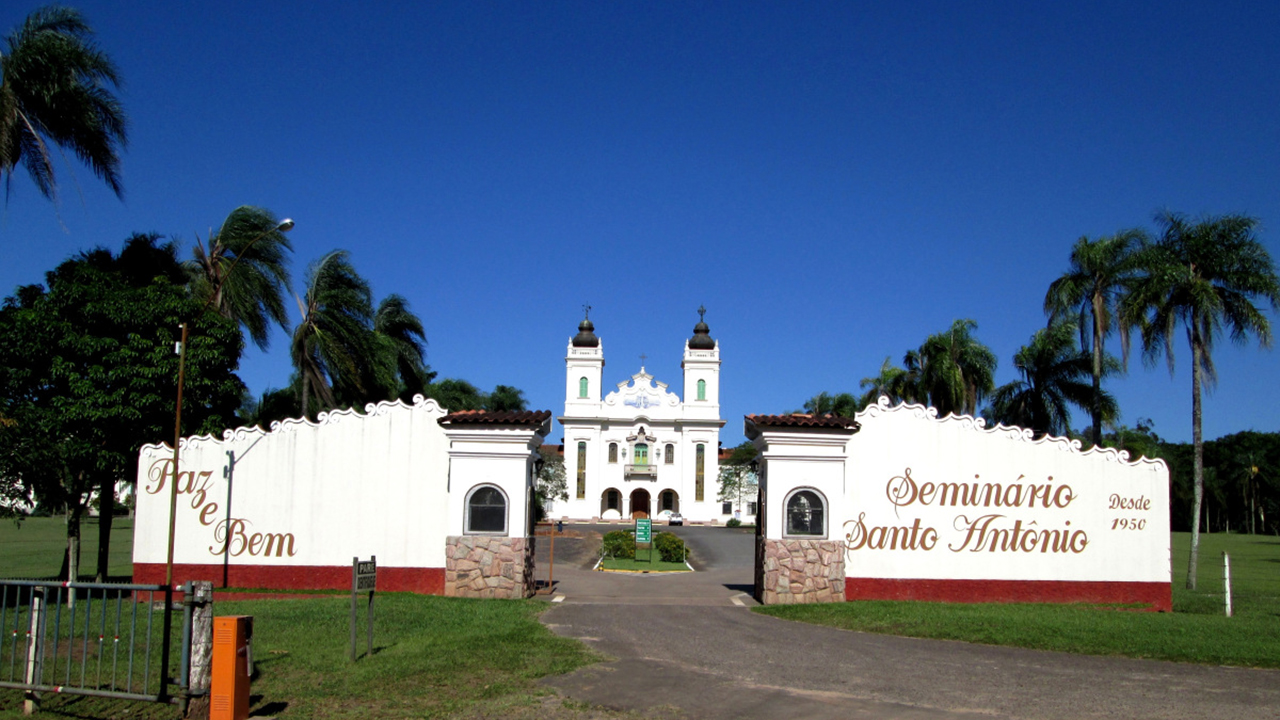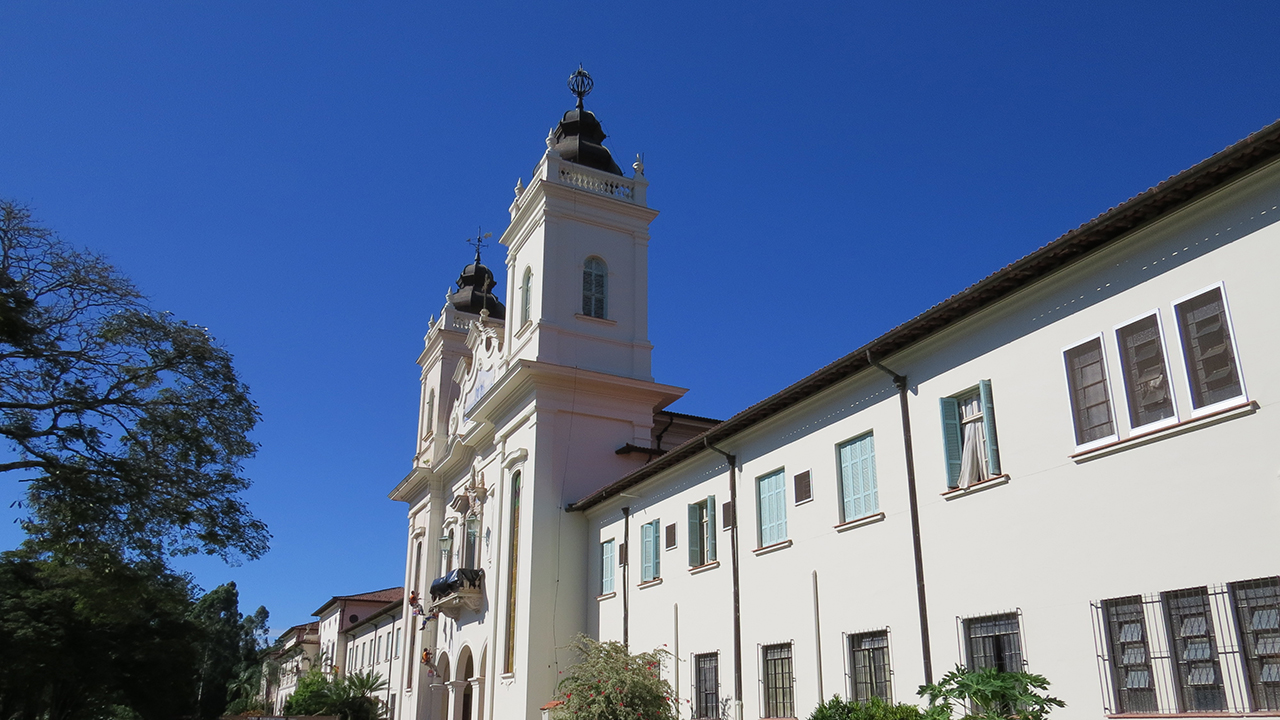Seminário Santo Antônio

O Seminário Santo Antônio surgiu da necessidade da Província Franciscana da Imaculada Conceição do Brasil de ter um local adequado para receber e formar seus seminaristas, uma vez que o então Seminário de Rio Negro (PR) se revelava pequeno diante das perspectivas de vocações no Brasil. Em 1943, o então Governo Provincial decidiu partir para uma nova construção em um local central da Província, com clima favorável, boa disponibilidade de água e perspectivas para um sustento autônomo e sadio para os jovens seminaristas.
Em 1945, partiram os frades a procura do local adequado para a nova construção. Chegaram a Agudos, onde já se encontravam as Irmãs Franciscanas de Siessen que muito se empenharam pela ida dos frades à cidade. O então prefeito da cidade, Pe. Aquino se entusiasmou pela ideia e, próximo à proprietária da Fazenda Santo Antônio, levou os frades até lá onde encontraram um local cultivado, com possibilidade de criação de gado plantação de pomares, com água e luz e muita área plana para a construção. O negócio foi fechado e começa então a construção do Seminário Santo Antônio de Agudos.
Os primeiros 70 seminaristas e 4 padres chegaram em 31 de Janeiro de 1950. As obras continuaram ininterruptas até 1955. Em dezembro de 1952, dois terços da casa já estavam de pé, em 1953 já eram 210 os seminaristas em Agudos.
O Fato mais significativo de 1955 foi a benção da Igreja em 11 de Setembro. Todo o mármore usado na sua ornamentação veio da Itália chegando apenas um mês antes da data marcada para a Inauguração. A Igreja foi dedicada à Imaculada Conceição, padroeira da Ordem Franciscana e patrona da Província.
O Órgão de Tubos foi construído pelo Sr. Siegfried Schürle e seu auxiliar August Pfau, ambos de São bento do Sul, Santa Catarina. Os estudos para a construção remontam a maio de 1959, a construção teve início no ano de 1961 e em 28 de Junho de 1962 o órgão foi inaugurado. É o maior do interior do estado de São Paulo, com 25 registros reais e 2.062 tubos.
O ano de 1959 marca o início da construção da piscina. Após o serviço de concretagem, em maio de 1960 ela foi enchida pela primeira vez para testar vazamentos, um milhão e quinhentos mil litros de água entraram nela. Em dezembro de 1960, dez anos depois da chegada dos primeiros seminaristas a turma pôde cair na piscina, que conta até hoje com estação de tratamento e reciclagem da água.
Ao longo desses 66 anos de existência, o Seminário Santo Antônio sempre teve suas alas cheias de seminaristas, hoje irmãos, padres e bispos a serviço da Igreja.
O carinho e o cuidado com esta casa nunca deixou de ser prioridade para todo frade, ex-aluno ou não. O local é também motivo de orgulho para a cidade de Agudos.
Missão: Ser uma Fraternidade de Acolhimento a frades, religiosos, padres e leigos na realização de encontros, retiros e eventos diversos, através do modo franciscano de ser. Estar a serviço da Igreja local nas Paróquias e Seminário e pela ação evangelizadora, ser testemunho da oração, do serviço e da alegria proporcionando a todos o crescimento espiritual.

Seminary of St. Antony
The St Antony Seminary arose from the need of the Franciscan Province of the Immaculate Conception of Brazil to have a suitable place to receive and train its seminarians, since the then Seminary of Rio Negro (PR) was revealed to be small in view of the prospects for vocations in Brazil. In 1943, the then Provincial Government decided to build a new building in a central location in the Province, with a favorable climate, good availability of water and prospects for an autonomous and healthy livelihood for young seminarians.
In 1945, the friars left in search of a suitable place for the new building. They arrived at Agudos, where the Franciscan Sisters of Siessen were already present, who worked hard to get the friars to the city. The then mayor of the city, Fr. Aquino was enthusiastic about the idea and, close to the owner of Fazenda Santo Antônio, took the friars there where they found a cultivated place, with the possibility of raising cattle, planting orchards, with water and light and a lot of flat land for construction. The deal was closed and construction began on the Santo Antônio de Agudos Seminary.
The first 70 seminarians and 4 priests arrived on January 31, 1950. The works continued uninterrupted until 1955. In December 1952, two thirds of the house were already up, in 1953 there were already 210 seminarians in Agudos.
The most significant event of 1955 was the Church’s blessing on 9/11. All the marble used in its ornamentation came from Italy, arriving just a month before the date set for the Inauguration. The Church was dedicated to the Immaculate Conception, patroness of the Franciscan Order and patroness of the Province.
The Pipe Organ was built by Mr. Siegfried Schürle and his assistant August Pfau, both from São Bento do Sul, Santa Catarina. Construction studies date back to May 1959, construction began in 1961 and on June 28, 1962 the organ was inaugurated. It is the largest in the interior of the state of São Paulo, with 25 real records and 2,062 tubes.
The year 1959 marks the beginning of the construction of the swimming pool. After the concreting service, in May 1960 it was filled for the first time to test leaks, one million and five hundred thousand liters of water entered it. In December 1960, ten years after the arrival of the first seminarians, the group was able to fall into the pool, which still has a water treatment and recycling plant.
Throughout these 66 years of existence, the Santo Antônio Seminar has always had its wings full of seminarians, today brothers, priests and bishops at the service of the Church.
The affection and care for this house never ceased to be a priority for every friar, former student or not. The place is also a source of pride for the city of Agudos.
Mission: To be a welcoming Fraternity for friars, religious, priests and lay people in holding meetings, retreats and various events, through the Franciscan way of being. Being at the service of the local Church in the Parishes and Seminary and through evangelizing action, being a witness of prayer, service and joy, providing everyone with spiritual growth.



